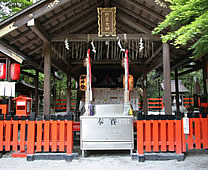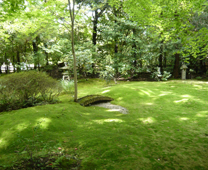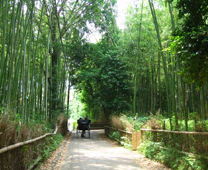
Travel Guide
Introduction
Nonomiya Shine, the small Shinto shrine, in a bamboo grove of Sagano area dates back to the seventh century and is noted for its ancient style of Kuroki No Torii (black torii gate). The torii is the only shrine in Japan with a torii gate that maintains its rough outer texture and its natural coloring (usually torii gates are red) and also the oldest Torii gate in Japan. In the grounds you can find a moss garden. Several gods are enshrined here. Several of them are a god of good match and marriage, a god of an easy delivery and a god of learning.
When you go through the torii, you will find a stone to the left called Kame No Ishi. It is said that your wish will come true within a year if you touch and stroke the stone while praying.
Nonomiya literally means something like a field palace. Saio, an unmarried Imperial princess who was selected by divination to serve the god of Ise Shrine, had to stay in a nonomiya for a year to purify herself before leaving Kyoto for Ise, and in The Tale of Genji (c. 1006) there’s a dramatic episode there involving Genji and Rokujo.
New Saio was assigned every time a new emperor acceded to the throne. Saios did not necessarily use a same nonomiya and this place was one of those nonomiyas. Therefore, the specific site of the shrine changed somewhat over time, as the location of the shrine was fixed anew by divination. The first Saio who used this place was a daughter of Emperor Saga (786-842). The institution of Saio was abolished in the era of Emperor Godaigo (1288-1339) but the nonomiya remained as a Shinto shrine, that is Nonomiya Shrine.
In literature
Nonomiya Shrine appears in the tenth chapter of the Tale of Genji.
There are many plays and other works which are based on the narrative of Genji. In the Noh play, The Shrine in the Fields by Zeami, a scene features a priest praying when a girl enters; and, upon questioning, she tells the story of how, when Lady Rokujo was staying at Nonomiya with her daughter who had been appointed as the Ise virgin, Genji came to her.
 |
 |
 |
| Main hall | The moss garden | Bamboo grove Nonomiya Banboo |
Travel Advice
Omamori mail order service
Nonomiya Shrine provides the Omamori (Japanese amulet) mail order service for who can’t visit the shrine. Please fill out the application form (Japanese only) on the official site and enclose the cash, then send it by registered mail. The shrine will deliver the Omamori with mail. You can’t specify the date of mailing. The deliverable area is Japan only.
Saito and Saigu
A Saio, also known as "Itsuki no Miko" was an unmarried female relative of the Japanese emperor, sent to Ise to serve at Ise Grand Shrine from the late 7th century until the 14th century. The Saio's residence, Saiku, was approximately 10 km north-west of the shrine. The remains of Saiku are situated in the town of Meiwa, Mie, Japan.
According to Japanese legend, around 2,000 years ago the divine Yamatohime-no-mikoto, daughter of the Emperor Suinin, set out from Mt. Miwa in Nara Prefecture in search of a permanent location to worship the goddess Amaterasu-omikami. Her search lasted for 20 years and eventually brought her to Ise, Mie Prefecture, where the Ise Shrine now stands. Prior to Yamatohime-no-mikoto's journey, Amaterasu-omikami had been worshiped at the Imperial Palaces in Yamato.
According to the Man'yoshu (The Anthology of Ten Thousand Leaves), the first Saio to serve at Ise was Princess Oku, daughter of Emperor Temmu, during the Asuka period of Japanese history. Mention of the Saio is also made in the Aoi, Sakaki and Yugao chapters of The Tale of Genji, as well as in the 69th chapter of The Tales of Ise (Ise Monogatari).
In the 13th century, Jien recorded in the Gukansho that during the reign of Emperor Suinin, the first High Priestess (saigu) was appointed for Ise Shrine. Hayashi Gaho's 17th century Nihon Odai Ichiran is somewhat more expansive, explaining that since Suinin's time, a daughter of the emperor was almost always appointed as high priestess, but across the centuries, there have been times when the emperor himself had no daughter; and in such circumstances, the daughter of a close relative of the emperor would have been appointed to fill the untimely vacancy.
The role of the Saio was to serve as High Priestess at Ise Shrine on behalf of the Emperor, to represent the role first set out by Yamatohime-no-mikoto. Three rituals a year were conducted at the Shrine in which the Saio prayed for peace and protection. In June and November each year, she journeyed to the Shrine to perform the Tsukinamisai Festival. In September she performed the Kannamesai Festival to make offerings to the gods of the year's new grain harvest.
For the rest of the year, the Saio lived in Saiku, a small town of up to 500 people approximately 10 kilometers north-west of Ise, in modern Meiwa, Mie Prefecture. Life at Saiku was, for the most part, peaceful. The Saio would spend her time composing waka verses, collect shells on the shore of Oyodo beach, or set out in boats and recite poetry upon the water and wait to be recalled to Kyoto.
When a former Emperor died or abdicated the throne, when the old Saio's relative died, or when certain political power required, she would be recalled to the capital and a new Saio selected from one of the new Emperor's unmarried female relatives using divination by either burnt tortoise shell or deer bones. The new Saio would then undergo a period of purification before setting out with her retinue of up to 500 people for Saiku, never to return to the capital until recalled by the next Emperor.
Upon the selection of the new Saio, the current Saio and her retinue would return to the capital to resume their lives as part of the Imperial Court. Often a Saio was quite young when she left the capital for Saiku, and would only be in her mid-teens or early twenties when she returned to the capital. It was considered a great honor to marry a former Saio and her time at Saiku improved her own position at court and those of the people who served with her.
Autumn Leaves
Nonomiya Shrine is a spot to see autumn leaves. Please see Autum Leaves in Nonomiya Shrine.
Events
| Events in 2019 | ||
| Saigu Procession | A parade based on the procession which was held about 660 years ago. Hundreds of people will walk with Saio (the girl) wearing gorgeous traditional cloths. | Oct 20(Sun) |
Saigu procession
In the Heian period, successive imperial princesses stayed in the Nonomiya Shrine for a year or more to purify themselves before becoming representatives of the imperial family at the Ise Shrine in Mie prefecture. Contemporary annual processions recreate a scene from a picture scroll of the imperial court during the Heian period, starting from the shrine and continuing as far as the Togetsukyo Bridge, Arashiyama. After the procession, a purification ritual is held.
Visit
| Address | 1 Saga Nonomiya-cho, Ukyo-ku, Kyoto-shi, Kyoto | |
| Phone | 075-871-1972 | |
| Admission | Free | |
| Hours | 09:00 to 17:00 | |
| Closed | Open 7 Days a Week | |
| Duration | 15 min | |
| Getting There | By Train 5 minute walk from Arashiyama Station on Keifuku Electric Railroad Arashiyama Honsen. By Car Take Meishin Expressway to the Kyoto-higashi exit. It is approximately 15 kilometers 50 minutes from exit. |
|
| Parking | No parking available | |

